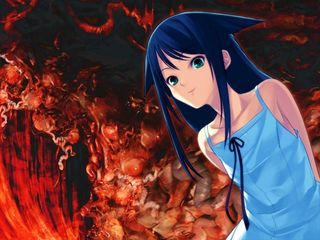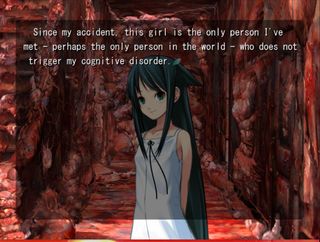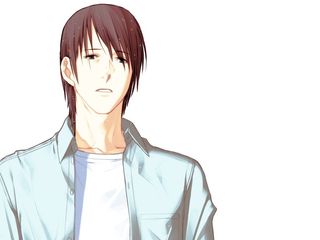I love Saya no Uta, even though it's incredibly messed-up
The NSFW visual novel released in Japan in 2003 is still giving players troubled dreams today.

After surviving a horrific car crash that kills his parents, Fuminori begins to perceive every other human being as what can only be described as wriggling lumps of flesh. He can barely understand the words spewing from their rancid, meaty appendages, but when he tries to explain what he's seeing he's restrained and drugged. He has no choice but to pretend everything is fine.
Even buildings and mundane objects take on a twisted, hellish cast. Language is garbled, sweet smells are rancid, and what was once ordinary is now sinister. He'll never again breathe the crisp, clean air of a summer day again, and never know the true beauty of the world as it once was.
Saya no Uta thrusts you into one of the most terrifying narratives ever conceived in a visual novel, a Lovecraftian hell evocative of stories like I Have No Mouth and I Must Scream. Unpleasant, right? But this is still a visual novel. You're probably thinking a beautiful girl comes along and makes it all better. That's where you'd be wrong. When Saya arrives, the one person who appears normal to Fuminori, she does not make it better. Saya makes things even worse.

While forced to navigate a world covered in entrails and meat sacks, Fuminori pushes away his entire circle of friends. He finds solace only in Saya. Outwardly she appears to be an innocent, emerald-haired young girl with childlike mannerisms, but it's impossible to tell her true age, her true motives, or her true form. Why, when Fuminori sees everything around him as a rancid slab of meat, does Saya appear so beautiful? These questions are answered as part of a uniquely violent, sickening ride. And it happens to be one of my favorite games of all time.
Saya no Uta also has an excellent soundtrack, on par with Silent Hill's. The first few grinding notes of 'Schizophrenia' perfectly embody the creeping frustration and self-loathing
Beyond a premise that will immediately turn some players off, Saya no Uta is a cavalcade of even more objectionable content just as likely to push players away. Not only are there descriptions of gratuitous violence, but sexual assault, adult scenes featuring a young-looking female character, and various other bits of awfulness are sprinkled throughout. It's entirely understandable that some players would skip it. But there's beauty in the madness, as twisted as that may sound.
As horrible as these things may be, they add up to a nihilistic feast. While finding a soulmate in a romantic dating sim may be the goal for some, I want to see the seedy underbelly, especially if it means confronting difficult content head-on. I know what it feels like to flirt, to fall in love. I want a game to show me things beyond what I could experience in real life, and so Fuminori's bizarre struggle is a tale I'm fascinated by.
I didn't know what to expect going into Saya no Uta when a good friend of mine recommended it to me years ago, and when I revisit it, I'm still trying to unpack the complex feelings it stirs up. After playing hundreds of both vanilla and explicit visual novels and their gaming offspring, I go back to it time and time again to let its melancholia wash over me.
The biggest gaming news, reviews and hardware deals
Keep up to date with the most important stories and the best deals, as picked by the PC Gamer team.
It's not just the story that gets me, though it's gripping and well-paced in a way that's rare for the genre. Saya no Uta also has an excellent soundtrack, on par with Silent Hill's. The first few grinding notes of 'Schizophrenia' perfectly embody the creeping frustration and self-loathing Fuminori has dealt with for months, a prisoner in his own mind. You can practically feel the descent into madness—a comfortable, familiar madness, and one that grips you tightly without letting go.
Fuminori's disconnect from the human world is something that, while we can identify with it, we should hope never to be forced to experience anything like it. Trying to place ourselves in the same situation he finds himself in is an exercise in compassion, though his abandonment of morals and justice in some of the story's branches (of which there are very few, with only a handful of decision points) are beyond understanding.

Still, at one time or another in our lives we've all felt ostracized. It's almost understandable that Fuminori gradually becomes a villainous creature who sees absolutely nothing wrong about his abhorrent life choices, nor the actions he's taken to get there. He's damned to an existence where any semblance of light seems nonexistent—who knows what we'd do when pushed to those extremes?
And so, despite all its horrific content (and in many cases because of it, including some of the grotesque fates that befall certain characters), Saya no Uta remains one of my most-played visual novels. Dark writings that drive their readers to obsession are a cliche of Lovecraftian fiction, and Saya no Uta is the real-world equivalent, a visual novel you shouldn't read for the sake of your own peace of mind, that should come with warnings that trail off into italics, ellipses, and madness and definitely not a link to its vndb entry.
Most Popular

